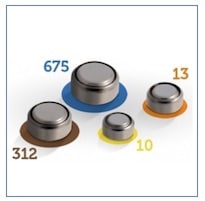People with hearing loss today understand that we thrive at the mercy of technology. We are battery-operated people. We need electricity to charge our devices. Technology rules!
I’m no tech wiz but I’m OK with the basics – the microwave, for example, although last night I did manage to crack the glass plate, and I know what buttons to push on the TV remote.
This is about the love ‘n’ hate affair some of us have with hearing technology. Hate is too strong a word – it’s more a mild to middling frustration with the processes involved. The Hearing Husband has learned to wait while I gather the bits I need to stream a TV show to my hearing aid and cochlear implant. Friends, that takes 5 hearing devices – FIVE! – and if you count the actual television, it’s SIX!
The TV streamer attached to the TV uses Bluetooth to stream to my left-side hearing aid via my cellphone, and to my right-side cochlear implant through a remote. If I’m on a Zoom call on my computer, I use my Cochlear MiniMic to move sound from the computer to my devices, again using the cellphone and a remote. Sometimes, to enhance understanding, I use a speech-to-text app on my phone to fill in the blanks of what I didn’t hear what someone. Someday, I’ll have a faster-zappier way to stream, but for now it’s a multi-device process.
And wow, what a fabulous job that process does! Full stereophonic sound in my head, something I’d not experienced in a long time. When birds sing on the TV, I hear them as if they’re in a tree outside my window. At first, I thought the crackling sound I was hearing was not a glitch in my technology, but the sound of the fireplace in Lorenzo de Medici’s villa. (I’m watching a lot of Netflix these days.)
This is almost as good as what hearing people hear! And what’s exciting is that there seems to be an infinite lineup of apps and devices waiting to give us, the people with hearing loss, a better-quality hearing experience and more satisfying communication. And in this pandemic time of online communication, we need all the help we can get.
But I have a problem. There are so many new fabulous things, I can’t keep up, and worry that I might be missing out on something that would be perfect for me. The latest-greatest thing that can help me hear and that allow me to see the spoken word translated into print. I do have regular sources for technical strategies: from other HoHs, other writers such as Shari Eberts and Katharine Bouton, Facebook groups, and consumer organizations such as Hearing Loss Association of America. But I can’t spend all my time scrolling and trolling the hearing loss world!
I recently discovered a wonderful website called Connect-hear.com, developed and managed on a voluntary basis by Catharine McNally and Tina Childress, two experts in hearing technology who also have hearing loss. The site isn’t fancy, but its Knowledge Base fills a crucial gap with its growing list of information and articles on the topics that are important to people with hearing loss such as dealing with masks, captioning, videoconferencing and accessibility.

Connect-hear.com
Catharine and Tina say on their site:
When the COVID-19 Pandemic began, our way of communicating with others shifted dramatically — more on video conferencing, more on phone calls. This presented a challenge to deaf and hard of hearing individuals: How will it be accessible? What are the captioning options? What about interpreting? Or transliterating?
After posting articles on strategies and tips for videoconferencing, we experienced a high volume of questions and discussions. We quickly realized that there was a real need for a consolidated place of information that people needed — and we got right to work.
“This is a time for experimentation and trying new things, including your listening device and figuring out what works best.”
Catharine and Tina continue to add content to the site, and I hope that when they have the time, they will also include information on assistive devices, which I know is a particular passion of Tina’s. These compassionate women say we’re all in this together, and I appreciate what they are doing to pull us together with accessibility information.
It’s the unbiased and comprehensive tech stuff that we, the battery-operated people, need.

Tina Childress

Catharine McNally








Looking for an answering machine that prints out message. Please HELP.
Please contact your local phone provider – they may be able to help.
Check into Captel phones. The answering machine in the Captel will caption the message on the screen. The internet model phone is like a regular phone. The captioning service is automatically available. If you don’t have internet, the person calling in must go through a toll-free number to access the captioning service. For a call that comes through without accessing the captioning service, the captioned message won’t be available. There are a few different brands of caption phones you can check into. Here’s one https://www.captel.com/.
Hope that helps!
Thank you for this article. I am also looking for the assistive listening set up that will help me hear better and having been closed in for several weeks I have found and discovered Dr. Cliff Olsen, but there is yet, in all my searching on web and Youtube no helpful solution. So having the ability to go to a website or youtube video would be awesome.
Sandra Davis
Gael, when you don’t need the stereophonic sound, just use your telecoils and a hearing loop (or neckloop) connected to your tv, computer, cellphone, tablet and virtually any sound source. Keep it simple and discrete with fewer batteries, fewer chargers and fewer devices.